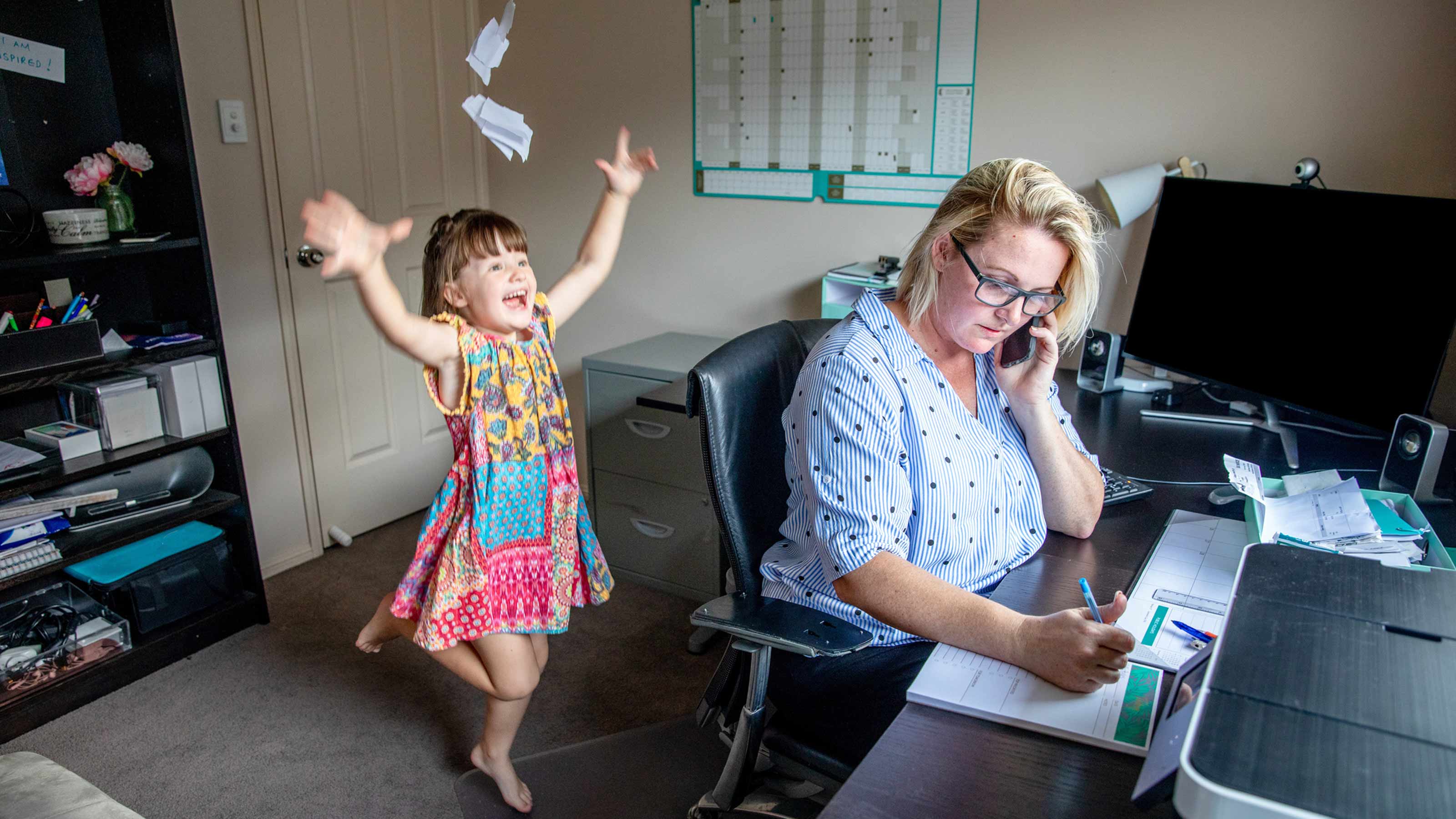Work-from-Home Survival Tips – Including Hacks for Handling Kids
A team of financial professionals weighs in on what works for them personally to stay productive and sane in the era of COVID-19.


Being a working mom was challenging prior to the coronavirus shutdown — juggling work, racing to school or sports, planning quick, nutritious dinners, and giving my kids and husband all the attention they deserved. Then COVID-19 hit, and life changed.
I’m not one who weathers change well, but within a few weeks — OK, maybe a month — I hit my stride. I get to see my kids more. I’m taking better care of myself and am enjoying work, tackling more issues and projects than ever before.
This reset was about adapting and thriving, and the guidance of my teammates at Halbert Hargrove was key. I’ve always looked to my colleagues’ best practices and adopted what makes sense for me, but never more than now. Here are some gems from our team’s thoughts on working from home successfully.

Sign up for Kiplinger’s Free E-Newsletters
Profit and prosper with the best of expert advice on investing, taxes, retirement, personal finance and more - straight to your e-mail.
Profit and prosper with the best of expert advice - straight to your e-mail.
Top Tips to Stay Productive at Home
As financial professionals, we’re focused on creating disciplined processes. Although COVID-19 posed a new set of challenges, we were ready to figure this out. Our tips could easily be applied to your own work-from-home situation.
Brenden Melrose, Wealth Advisor, San Diego:
- Working from home makes it easy for work/life boundaries to blur. Having a dedicated space puts my mind in work mode when I get there. It doesn’t have to be an office or a desk — just the same space every day. Moving from spot to spot in the house doesn’t allow for a consistent work environment.
- Keeping a schedule allows me to be fully present for both work and life. With easy access to my office and tasks, it’s easy to slip away after hours to get “a couple quick things done.” Conversely, it’s just as easy to step away to do things around the house. If you keep a routine of a dedicated work block and personal time, you’ll be able to focus knowing you are giving appropriate attention to each.
- I make it a habit to turn off the computer when my workday is done. Having to boot up is a great deterrent to lapsing back into work mode.
Cecilia Williams, Director of Investment Operations/CCO, Long Beach
- Set up a workspace that keeps you focused and motivated. The right chair, desk height, lighting, etc. matters when you think about how many hours a day you spend staring at your screen.
- Look for online training and learning opportunities. We’re now missing an extra element of the storytelling/training that happened just by being next to one another in the office. Join a webinar, read articles, make sure you don’t zone out so much on your specific role that you forget that focus on self-improvement.
- Start and end your day consistently. I make sure everything unrelated to work is cleared off my desk each morning, that I have my coffee in hand, and spend the first 10-15 minutes organizing my day, listing priorities and moving things around to make my day more successful. I end each day the same way, making sure I have looked at what needs to get done the following day. This helps me mentally unwind. It will all be there tomorrow!
Tony Collins, Associate Wealth Advisor, Long Beach:
Having more frequent voice and video calls with my team helps keep me more motivated, stay productive and feel more connected with the work I’m doing. It’s easy to get bogged down by email and instant messages, and sometimes things can be lost in translation. Nothing beats direct conversations in getting issues prioritized and ironed out.
Craig Eissler, Wealth Advisor, Houston:
Invest in some earbuds that allow you to stay connected to your phone — rather than tethered.
Best Practices for Working at Home with Kids
Kids and work are definitely not an optimal pairing — before COVID-19, it was a big no-no for many companies. But many of us enjoy the kids who have appeared on screen or snuck into the background of a Zoom call. The majority of our advisors have children — and have figured out ways to “make it work.” Here are some highlights.
David Koch, Senior Wealth Advisor, Long Beach:
- Break up the day into manageable chunks. Your kids can’t sit still without a recess at school, what makes you think they can do it at home? Consider the Pomodoro Technique. This is a time-management method developed by Francesco Cirillo in the 1980s, which uses a timer to break work into 25-minute chunks separated by short breaks. The “Pomodoro” (tomato in Italian) comes from the tomato-shaped kitchen timer he used to keep track. The technique helps to divide large projects into smaller, more manageable ones and supposedly improves creativity and concentration. Meanwhile, use your breaks to check in with the kids and have a recess.
- Rowdy kids? I make them do burpees. I tell my kids, “You’re either going to get smarter or you’re going to get stronger, and right now, you’ve chosen to get stronger.” I usually start with 10, but escalate to 15 or 20 if I get any lip. If they complain, I’ll add more and let them know that, “Pain is just weakness leaving your body.” Pro tip: During schooltime (M-F 9 am-3 pm), I make them respond to every order I give them with, “Aye aye, captain,” and a small salute. This ensures they know I mean business.
- Going to jump on a work call? Put a sock on the doorknob. That’s their signal not to interrupt.
- Checklists, checklists, checklists. Make one for you and one for the kids. You can’t give your kids one task at a time — it’s just not efficient. Make a list, write it down, and have them check items off as they go through their day. Not only does this give them direction (when you may still be on that one-hour call 90 minutes later), but it gives them a sense of accomplishment — and a chance for you to reward them. Incentivize them to make a stretch goal, and reward them for hitting it — or even for a strong effort.
- Prep meals ahead of time, and keep plenty of snacks on hand. Batch process a stack of PB&Js, make sure you’ve got all the ingredients for Triscuit nachos, hoard those boxes of Stouffer’s French Bread pizza, pre-slice five apples at a time, stock big bags of organic baby carrots, break out that Crock Pot — or better yet, the Instant Pot. Now is your chance to make that slow-roasted recipe that makes several meals at once.
- Let the kids take advantage of all the amazing media out there. Now is not the time to ration their screen time. You can use it as a reward for them to watch their favorite slime videos (anyone else have a 6-year-old girl?). There are phenomenal apps, podcasts and YouTube channels to augment their education as well. Khan Academy is a staple in our home — there’s the Khan Academy app, the YouTube channel, and now there’s a Khan Academy Kids app as well. The Brilliant app is great for math. There are TED Talks galore that discuss subjects your kids might be into. Have a burgeoning entrepreneur? Let them watch Shark Tank!
Craig Eissler, Wealth Advisor, Houston:
- While on a conference call, utilize the mute button on your phone as much as possible whenever you are NOT talking.
- Establish some boundaries. Walls and doors work great.
- Utilize the virtual backgrounds feature in Zoom. Kids can run and dance all they want behind you. No one will see them.
Finally, My Own Input
After connecting with my team, I developed my own top tips:
- If I have a particularly important meeting, my kids are sent on a long walk around the neighborhood with their caregiver, so there’s no chance of an interruption.
- My 5-year-old has a set-up on the window seat in my working room with markers, crayons, coloring books, Legos, books, etc. to self-entertain for parts of the day.
Whether you’ve enjoyed this change — or you’re eagerly anticipating the day you can return to the office — there are ways to thrive in this new environment. If you seek advice and are open to changing your routine, the aha’s will come. Just keep experimenting with new solutions, and some are bound to bear fruit.
Get Kiplinger Today newsletter — free
Profit and prosper with the best of Kiplinger's advice on investing, taxes, retirement, personal finance and much more. Delivered daily. Enter your email in the box and click Sign Me Up.

Kelli Kiemle holds multiple roles with Halbert Hargrove. As Managing Director of Growth and Client Experience, she sets the tone for the quality and character of Halbert Hargrove's client service relationships. She also manages the associate wealth advisers and client service managers. Kelli is also responsible for overseeing the firm's wide-ranging marketing and communications initiatives, including their mentor program.
-
 Are You Ready to Pay More Taxes to Save Social Security?
Are You Ready to Pay More Taxes to Save Social Security?Social Security Across party lines, many believe saving Social Security trumps other financial considerations.
By Kelley R. Taylor Published
-
 Annuities: Do You Need Guaranteed Income In Retirement?
Annuities: Do You Need Guaranteed Income In Retirement?Annuities are now an option in some 401(k)s but that doesn't mean they should be included in your retirement plan.
By Donna Fuscaldo Published
-
 Little-Known Ways to Guard Your Retirement Income
Little-Known Ways to Guard Your Retirement IncomeIs your retirement income safe if stocks continue to plummet? Most retirees don't know these reliable options to limit their market exposure.
By Jacob Cornell Published
-
 Three Warning Signs Your Investments Are (Needlessly) Too Risky
Three Warning Signs Your Investments Are (Needlessly) Too RiskyAll investments come with risk, but the secret is to take only enough risk to get you to your specific savings goals — and no more than that.
By Eric Roberge, Certified Financial Planner (CFP) and Investment Adviser Published
-
 His Employees Don't Work 'For' Him, But 'With' Him
His Employees Don't Work 'For' Him, But 'With' HimWhile it might not seem that way, there are indeed employers out there who value the relationships they have with their employees. Here's an example.
By H. Dennis Beaver, Esq. Published
-
 Reduce Your Retirement Tax Risk With the Three-Bucket Strategy
Reduce Your Retirement Tax Risk With the Three-Bucket StrategySplitting retirement funds into three buckets with distinct tax treatments can help you avoid a nasty tax bill down the line. Here's how the strategy works.
By Bryan S. Slovon, Investment Adviser Published
-
 Financial Fact vs Fiction: This Roth Conversion Myth Could Cost You
Financial Fact vs Fiction: This Roth Conversion Myth Could Cost YouWhile some 'golden rules' stay in style forever, the financial landscape is constantly evolving. Here are five common myths to revisit (with more on the way).
By Scott McClatchey, CFP® Published
-
 Give Now or Leave an Inheritance? How to Balance the Options
Give Now or Leave an Inheritance? How to Balance the OptionsYou've saved enough money for retirement. But can you afford to give some to family or good causes — and when is best? These are the key points to consider.
By Deana Healy, CFP® Published
-
 How to Age-Proof Your Retirement Plan
How to Age-Proof Your Retirement PlanLongevity risk is a big threat to your retirement, but there are several strategies to protect yourself from running out of money, no matter how long you live.
By Nico Pesci Published
-
 Retirement Planning for Couples With a Generation Gap
Retirement Planning for Couples With a Generation GapDo you and your partner have different retirement timelines and attitudes to saving? It is possible to make plans together. This is how one couple did it.
By Phil Wright, Certified Fund Specialist Published